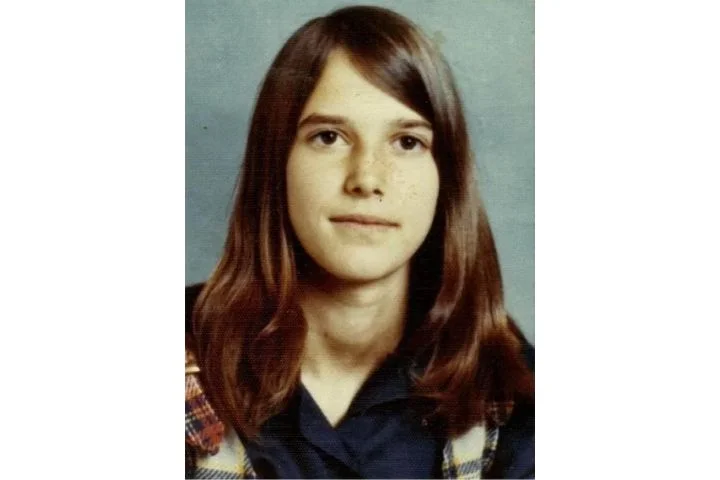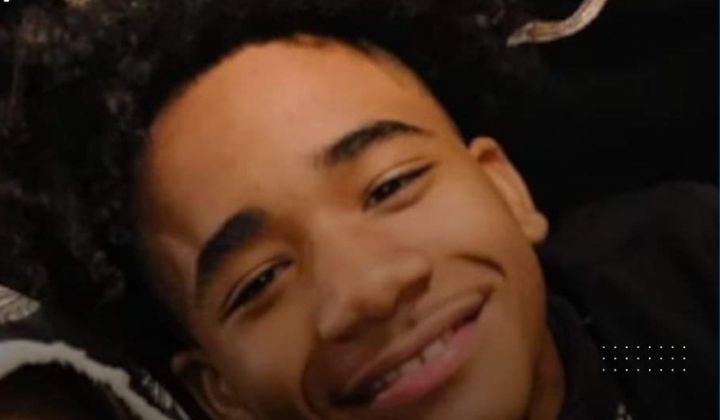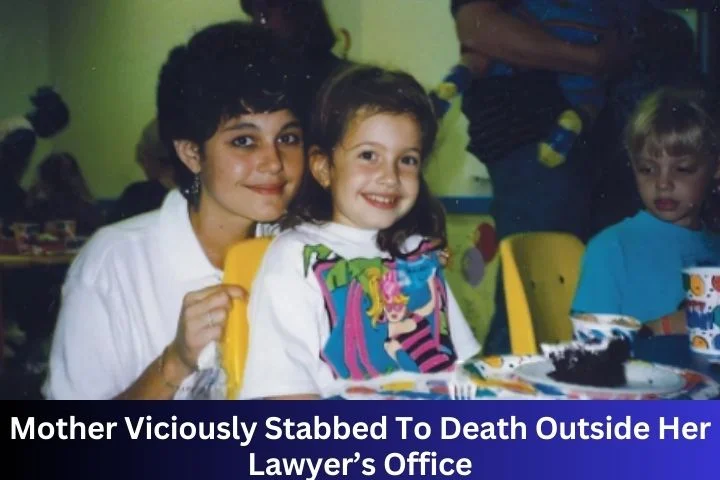Kathy Gloddy left her Franklin, New Hampshire home around 5:00 pm on Sunday, November 21, 1971. The 13-year-old, accompanied by her German Shepherd, Tasha, headed for nearby Bell’s Variety Store to pick up a couple of things. Once at the store, she selected some ice cream and potato sticks; she paid for her purchases and then she and Tasha headed off in the direction of their home. Tasha arrived at the house, but Kathy didn’t.
When Tasha showed up at the house without Kathy, her family immediately knew something was wrong. Kathy’s sister, Karen, recalled, “The dog climbed up on the doors and was clawing at the door, just scratching at the door to get in.” Once Tasha was let into the house, she frantically ran through it as if searching for Kathy.
The family immediately started looking for Kathy, who was the youngest of six children. They scoured the route Kathy would normally take to Bell’s Variety Store but found no sign of her, though the store clerk confirmed that she had made it safely there. What happened to her after she left the store was a mystery.
Concerned that something terrible had happened, Earl and Lucille Gloddy called the Franklin Police Department and attempted to report their daughter missing, but were told they had to wait 24 hours before they could file a missing person report. The family continued their search throughout the night, calling all of Kathy’s friends and checking every place they could think of where she might be. There was no sign of her anywhere.
The Gloddy family didn’t sleep at all on Sunday night. Their search for their youngest daughter, Kathy, went on and on as they drove up and down the empty streets of town. The police arrived at the house early Monday afternoon and told the family the terrible news they had been waiting for: Kathy’s body had been found in West Franklin; she had been ki*lled.
Kathy’s body was found in the woods near a road that leads to the town dump. This was three miles from the store where she was last seen. A man named Alfred Mondor found her. At first, he thought someone had left a d*ead deer by the road. He didn’t know he was looking at a girl until he got closer. He was so scared that he ran home to call for help.
When the police arrived, they quickly found that Kathy was d*ead. She had been raped, hit by a car, and beaten several times. An autopsy showed that she had suffered serious injuries to her head, neck, and abdomen. Warren Rudman, the attorney general of New Hampshire, told reporters, “There is evidence that all three injuries were serious and that any of them could have been fatal.”
The brutal k*illing shocked the people of Franklin and made them worry about their own safety. Rudman told reporters, “We are questioning a huge number of people all over the state about this.” We’re paying close attention to a number of people.” Even so, he admitted that they hadn’t been able to come up with any good suspects. “There have been no arrests and no one is being held.”
There was a funeral for Kathy that Friday. More than 300 people came to the service. Many of them were Kathy’s St. Mary’s Junior High School classmates. There were also a lot of police at the funeral because the kil*ler might have been from the area and wanted to show up. They were looking through the crowd for anyone acting strangely.
Kathy’s friends said she was a quiet girl who liked going to the Henry J. Proulx Community Center. She liked playing baseball in the sand a lot and was known as a tomboy. Sister Victorine, the principal of St. Mary’s, told police that she was sure the teen would never have agreed to ride with a stranger on their own. If she got into a car with her k*iller, she either knew him or was taken from her by force.
A classmate of Kathy’s, Leo Cote, later told reporters that there was a lot of talk about who might have k*illed Kathy. “Because the coffin was closed, we knew she had been beaten.” They were also adults because she could have dealt with any kid her age. That strong and quick.”
It had been a month since Kathy was k*illed, and no one knew who did it. Franklin Police Chief James Nowell said that some local businessmen were offering a $2,500 reward for information that led to the arrest and conviction of the person who committed the horrible crime. He did this in the hopes of getting more tips.
Attorney General Rudman was still hopeful that the k*iller would be caught. “The case has been moving forward steadily since the start. We are always looking at new information.” He said that the case was being worked on by state, county, and local agencies together, and he was sure that they would solve it.
The reward for information in the case was raised to $2,600 in February, and police asked the public once more for anyone with information to get in touch with them. Chief Nowell told reporters that police were still talking to people about the mu*rder, but they didn’t have any solid suspects yet. “Any information will be helpful, no matter how small.”
The case seemed to stop moving forward for months. It was soon November again, and the Gloddy family was getting ready for their second holiday season without Kathy. These past twelve months had been hard for the family, and they still hoped that Kathy’s ki*ller would be caught soon.
By 1973, Kathy’s case was no longer in the news, and the investigation stopped. Over the next ten years, it would be opened again and again, but no one would be arrested. In 1983, the case was looked at again by investigators. Forensic psychologist John Philpin helped them by making a profile of their suspect that seemed likely. “He gave us new leads,” said Franklin Police Sgt. Michael Chesney. This is the first time I’ve used a psychologist, but his profile was great.
Reporters were told by Sgt. Chesney that the police knew who the suspect was but didn’t have enough proof to charge him. This k*iller seemed to fit John Philpin’s description of the person who did it. “The suspect fit the profile 25 times out of 26 points; he was right on target with everything.” Sgt. Chesney refused to give any more information about the suspect.
The police had a strong suspicion, but they couldn’t do much because they didn’t have solid proof linking him to the crime. According to Detective Roland Lamy of the New Hampshire State Police in 1987, “The suspect has refused to answer any police questions, therefore the police are handcuffed.”
Detective Lamy was haunted by Kathy’s d*eath. He told reporters that he was sure he knew who ki*lled her and that not being able to prove it broke his heart. “He could be brought to court if we could just get a little more proof.”
In July 2006, 62-year-old Edward Dukette walked into the lobby of the Dixie County Jail in Cross City, Florida, and told staff, “I need to be arrested.” This brought Kathy’s case back into the news. In spite of being hooked up to an oxygen tank, the man said he had ki*lled a schoolgirl in New Hampshire in 1971. The police in New Hampshire confirmed that Dukette was a suspect in Kathy’s d*eath.
The Gloddy family knew Edward Dukette because Kathy’s sister Karen had babysat his son at least once. Dukette lived in Franklin at the time of Kathy’s de*ath. He had left New Hampshire not long after Kathy was ki*lled. His name came up as a suspect early on in the case, but there was never any real proof against him. He was now admitting to the m*urder 35 years after it happened.
Dukette told the police that he couldn’t remember if he raped Kathy or not, but he was with her when she died and chose to bury her. “He puts himself as the last person with her alive, and he puts himself with her when she’s de*ad, but he doesn’t put himself as knowing what happened or how she died,” said Maj. Dean Miller of the Dixie County Sheriff’s Office.
Dukette changed his story a week after admitting to the crime, saying that he had been recovering from surgery and wasn’t sure where he was at the time. He told a reporter, “I have a disease. My oxygen and blood gases sometimes go off at the same time, and I get lost. It’s a mess.”
Some of Dukette’s claims were not supported by physical evidence. For example, he said he buried Karen, but she was found lying next to a dirt road. Detectives still thought he might have been involved and set out to find proof. The police dug up Kathy’s body on July 25, 2006. They were hopeful that they could find DNA evidence that would help them find her kil*ler. At the cemetery, some of her siblings gathered to watch with heavy hearts as her body was brought to the surface.
Officials said that the forensic anthropologist who did Kathy’s autopsy in 1971 had noticed that she had a lot of sperm in her body, but no sample of it was taken. After more than 35 years, investigators knew they had a very small chance of getting DNA evidence that could be used, but they were determined to give it their all. It’s too bad that the sample they got was too damaged to be useful. After two years, Edward Dukette died, and Kathy’s case stopped being looked into.
Roger Gloddy, Karen’s brother, told the press that he never thought Kathy had been k*illed by just one person. “I know that more than one person took part.” I know there was a cover-up. They weren’t fools or stupid; they were just bad. He had always thought Dukette was guilty. “For sure, I think he was there when she died.”
Leo Cote, a classmate of Kathy’s, told reporters that Franklin had a lot of sketchy people living in it in 1971. “In those days, Franklin was nothing but a porn for hire.” Because of that, I can’t fully blame the police. One hundred other people could have also done it. She knew a lot of them. That is the issue. A lot of these people were real people she knew.
Kenneth Bonefant, 65, told reporters in October 2009 that he knew he had been a suspect in Kathy’s mur*der for a long time but swore he had nothing to do with it. It was the first time he had talked about the case in public. “I had no idea who she was.” I didn’t k*ill her at all…I wasn’t even close to her house.
He had changed the tires on his car just hours after the body of the teenager was found, so investigators said they thought he might have been guilty from the start. Given that Kathy had been hit by cars several times, they thought this was very odd. On the other hand, Kenneth said that his tires were just worn out from traveling as a salesman for Philip Morris and that the timing was just a coincidence. Before he left on his business trip that day, he thought it would be best to get new tires for his car because it was supposed to snow.
Reporters asked Kenneth why he stayed in Franklin after the mur*der. He said he had nothing to hide. He said he had never been in trouble with the law and had no desire to k*ill girls under the age of 18. “I know it’s not fair to make fun of my name when I had nothing to do with it,” she said.
New Hampshire Assistant District Attorney Will Delker confirmed to reporters that Kenneth was the last living suspect in Kathy’s murd*er. “Police spent a significant amount of time focusing on his activities around the time of Kathy’s disappearance. He has never been ruled out as a suspect in the case.”
While Kenneth protested his innocence, some of those who knew him weren’t so sure. Grace Dodge told police that Kenneth had shown up at her house on the night of the m*urder; he claimed that he had no heat at his house and asked if he could stay with her. She recalled that he had been drinking, something that was out of character for him, and he appeared to be upset about something.
Later, Kenneth told Grace that he had hit a deer and had thrown its body into the trunk of his car; he claimed that due to this accident, he needed to replace his tires and the carpeting in his trunk. She didn’t think much of it at the time, but once she learned about Kathy’s de*ath, she wondered if there was a more ominous reason Kenneth needed to replace the carpeting.
There were many who believed that Kenneth had kil*led Kathy, but they noted that he was good friends with a Franklin police officer and there was speculation that this was the reason why he was never charged. Many of the people who could have testified against him have since died, and it seems unlikely that charges will ever be brought.
Kathy’s sister, Janet, is the only member of her immediate family who still lives in New Hampshire. Her father died in 1992 and her mother died in 1997, and her siblings moved to various states across the country. Another sister, Karen, has written two books about Kathy’s unsolved mur*der. Although her siblings continue to hope that Kathy’s k*iller will one day be brought to justice, there has been little progress on the case in recent years.
Kathy Lynn Gloddy was just 13 years old when she was brutally mu*rdered in November 1971 in Franklin, New Hampshire. Although investigators have looked at a number of potential suspects over the years, no arrests have been made and the case has long since gone cold. Friends and family members continue to remember Kathy each year on the anniversary of her d*eath, and they hope that police will eventually get the tip they need to finally obtain justice for Kathy. If you have any information about Kathy’s mu*rder, please contact the Franklin Police Department at 603–934–2535 or the New Hampshire Cold Case Unit at 603–271–3658.






